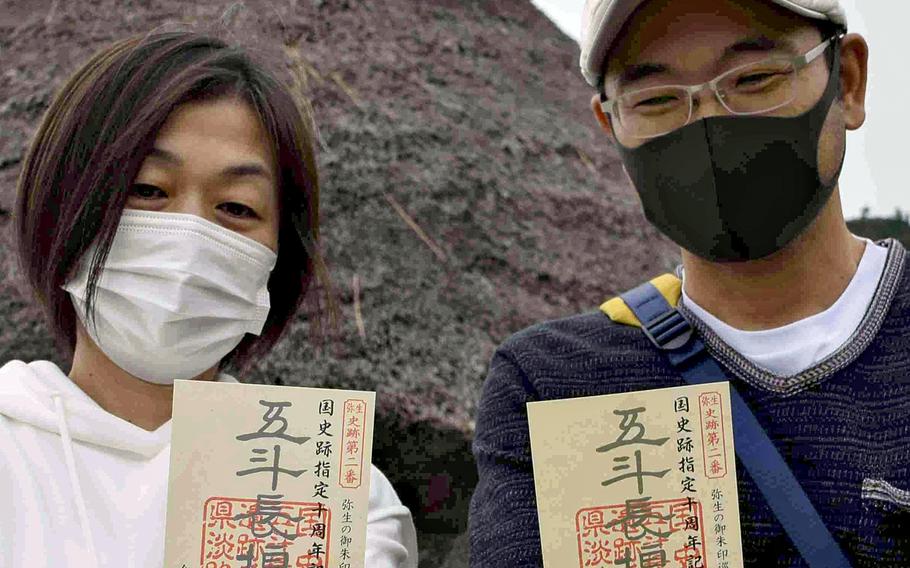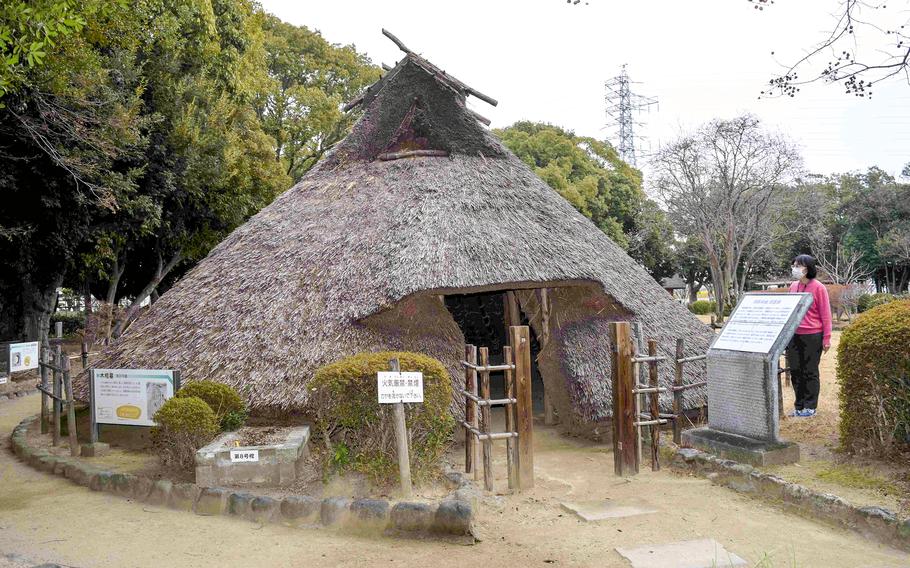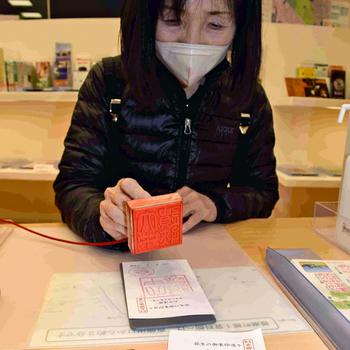
The goshuin stamp offered at the Gossa-Kaito ruins in Awaji, Hyogo Prefecture. (The Japan News)
Visiting ruins from the prehistoric Yayoi period and collecting goshuin stamps there has recently been seeing a quiet rise in popularity.
The Yayoi period started several hundred years before Christ and continued until around 300 A.D., when rice production began in Japan. Archaeological ruins from the period are found all over the country.
To promote the Yayoi period ruins that they manage, museums and other facilities have begun offering original goshuin stamps, which are usually available at temples and shrines for people to commemorate their visit. It seems that the museums’ and other facilities’ goshuin stamps resonate with archaeology enthusiasts and others not only due to their unique designs but also because they include catchphrases that capture the characteristics of each individual site.

A re-created dwelling from the Yayoi period in the Tano ruins in Amagasaki, Hyogo Prefecture. (The Japan News)
The Tottori prefectural government’s “Tottori Yayoi Kingdom” promotion department has arranged a scavenger hunt-like activity, in which participants collect goshuin stamps from Yayoi period ruins throughout Japan. Tottori Prefecture is home to such Yayoi period ruins as the Aoya Kamijichi ruins, where many wooden artifacts and other items have been discovered. The prefecture started the project to help increase the number of visitors to these and other ruins.
The rules of the project require facilities related to Yayoi period ruins to come up with their own catchphrases and for the size of the goshuin stamps not to exceed a length of 15.5 centimeters and a width of 9 centimeters. The project started in October 2022 at 19 ruins and 20 facilities around the country. Currently, 35 ruins and 38 facilities in 16 prefectures are participating.
Among the areas involved in the project, Hyogo Prefecture is first in terms of the number of participating sites it has, with six ruins and seven related facilities. Many sites from the Yayoi period exist in the prefecture, and several of them are known for their unique remains, such as an old village, an iron workshop and burial mounds. The Onaka ruins in Harima, the Tano ruins in Amagasaki and the Gossa-Kaito ruins in Awaji, all in the prefecture, have been participating in the project since it started.

The goshuin stamp of the Onaka ruins, center, in Harima, Hyogo Prefecture. (The Japan News)
The catchphrase for the Onaka ruins refers to the site as a Yayoi housing exhibition. About 140 round, hexagonal and other shaped pit dwellings were discovered there and at adjacent ruins. The Hyogo Prefectural Museum of Archaeology and the Harima town history museum are participating in the project in collaboration with the ruins.
“I hope the activity will provide an opportunity for people to get interested in archaeology,” an official of the archaeology museum said.
The catchphrase for the Gossa-Kaito ruins references a Yayoi blacksmith workshop, as iron artifacts were discovered in a pit-type building site at the ruins.
Meanwhile, the Kamo ruins in Kawanishi, which feature the remains of a settlement surrounded by a moat, have a catchphrase meaning “Yayoi hilltop moated settlement.”
For the Shingu Miyauchi ruins in the city of Tatsuno, the catchphrase notes that the site houses one of the biggest Yayoi villages in the Harima region, the southwestern part of Hyogo Prefecture. The catchphrase for the Une ruins in the city of Ako incorporates an allusion to the burial mounds of powerful leaders that characterize that site. All three of these latter ruins, also in Hyogo Prefecture, joined the project last year.
Outside the prefecture, the catchphrase for the Yoshinogari ruins in Saga Prefecture, where the appearance of a village in the Yayoi period has been re-created, is “Listen to the Yayoi Voice,” while the catchphrase for the Toro ruins in Shizuoka Prefecture can be translated to “It all began at the Toro ruins,” noting that the ruins of Japan’s first rice paddy were discovered at the site.
The designs of each location’s goshuin stamps are unique and distinctive.
The Onaka ruins’ goshuin stamp includes the kanji characters of its name and a picture of Hottan, the archaeology museum’s mascot. The goshuin stamp of the Ikegami-Sone ruins, offered by the Osaka Prefectural Museum of Yayoi Culture in Izumi, Osaka Prefecture, incorporates an illustration of a dragon believed to have been drawn by a person from the Yayoi period. At the Sugu Okamoto ruins in Kasuga, Fukuoka Prefecture, the site’s goshuin stamp carries a picture of a bronze mirror, one of the most representative artifacts discovered at those ruins.
A postpandemic travel boom is partly behind the project’s ability to draw interest.
According to the Hyogo Prefectural Museum of Archaeology next to the Onaka ruins, visitors come to collect its goshuin stamp not only on weekends but also weekdays.
“We hope people visit ruins across the country and collect unique Yayoi period goshuin stamps,” said Hiroshi Nakamura, an official at the museum.